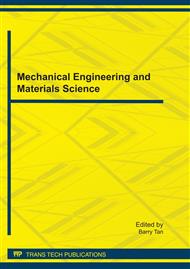[1]
Zhang YX, He CH. 2006. Process for Extracting and Separating Total Flavonoids from Leaves of Phyllostachys pubescens. Journal of Chemical Engineering of Chinese Universities. 5: 690-695.
Google Scholar
[2]
Fang W. 1994. Bamboo Taxonomy. Forestry of Chinese Publishing House. pp.56-60.
Google Scholar
[3]
Lu B, Wu X, Tie X, ZhangY, Zhang Y. 2005. Toxicology and safety of anti-oxidant of bamboo leaves. Part 1: Acute and subchronic toxicity studies on anti-oxidant of bamboo leaves. Food and Chemical Toxicology. 43(5): 783-792.
DOI: 10.1016/j.fct.2005.01.019
Google Scholar
[4]
Jin F. 2008. Study on extraction process of flavonoids from bamboo flavones with supersonic extraction. Journal of China Condiment. 4: 55-57.
Google Scholar
[5]
Li AP, Xie BX, Zhong QP. 2008. Evaluation of Antioxidant Activity of Phyllostachys pubescens Extracts. Food Science. 29(5): 97-98.
Google Scholar
[6]
Jiang L, Jiang LK, Chen KW. 2009. Ultrasonic Extraction Conditions of Bamboo Shell Flavones and Its Antioxidative Activity on oil. Natural Products Research and Development. 21: 146-151.
Google Scholar
[7]
Guo XQ, L B, Ruan XS, Lou YF, Lin XC, Tang DQ, Fang W. 2009. Genetic Diversity of Ten phyllostachys edulis Cultivars with ACGM Markers. Scientia Silvae Sinicae. 4: 28-31.
Google Scholar
[8]
Yang YF, Huang CL. 2009. A Study on the Flavonoid Compound in Bamboo Shoots of Three Pleioblastus Species. Journal of Bamboo Research. 1: 56-60.
Google Scholar
[9]
Huang HY, Deng B. 2009. Extraction of Total Flavanone from Pleioblastus amarus Leaves by Ultrasonic and its Antioxidation Effect. Lishizhen Medicine and Materia Medica Research. 6: 1443-1445.
Google Scholar
[10]
Wang CH, Zhong, XH, Li LD, Zhang M, Chu, ZH. 2009. Study on the extraction of polyphenols from the persimmon in the leaves. Progress in Modern Biomedicine. 9: 4540-2442. Table 1. The contents of total flavonoids and total phenols in shoots and shells of eight cultivars of bamboo. Variety shoot of bamboo shell of bamboo TF(mgRE/g) TPA(mgGAE/g) TF(mgRE/g) TPA(mgGAE/g) Edulis.
Google Scholar
[3]
088±0. 002.
Google Scholar
[13]
087±0. 001.
Google Scholar
[5]
455±0. 019.
Google Scholar
[15]
622±0. 011 Gracilis.
Google Scholar
[2]
363±0. 010.
Google Scholar
[12]
124±0. 022.
Google Scholar
[6]
075±0. 011.
Google Scholar
[15]
315±0. 015 Tao Kiang.
Google Scholar
[3]
352±0. 005.
Google Scholar
[13]
893±0. 001.
Google Scholar
[5]
022±0. 013.
Google Scholar
[15]
161±0. 031 Heterocycla.
Google Scholar
[1]
938±0. 021.
Google Scholar
[10]
672±0. 038.
Google Scholar
[6]
325±0. 008.
Google Scholar
[16]
692±0. 028 Aureosuleata.
Google Scholar
[2]
356±0. 023.
Google Scholar
[12]
053±0. 001.
Google Scholar
[2]
138±0. 001.
Google Scholar
[12]
598±0. 001 Aureocarlis.
Google Scholar
[3]
163±0. 026.
Google Scholar
[13]
444±0. 022.
Google Scholar
[1]
346±0. 010.
Google Scholar
[9]
264±0. 021 Spectabilis.
Google Scholar
[4]
088±0. 033.
Google Scholar
[14]
642±0. 010.
Google Scholar
[1]
292±0. 002.
Google Scholar
[9]
103±0. 004 Pekinensis.
Google Scholar
[2]
763±0. 012.
Google Scholar
[12]
529±0. 038.
Google Scholar
[1]
349±0. 012.
Google Scholar
[9]
359±0. 021 *Values are expressed as means ± standard deviation (n=3). Using LSD multiple comparison, significance level a=0. 05, Means with different letters were significantly different at the level P < 0. 05. Table 2 The total reducing capacity and the scavenging capacity in the shoots and shells of eight cultivars (in two species) bamboo. Variety Eubescens Gracilis Tao Kiang Heterocycla Aureosuleata Aureocarlis Spectabilis Pekinensis DPPH shoot of bamboo.
Google Scholar
011 sheel of bamboo.
Google Scholar
012 Table 3 The relativity analysis between the TF and TP contents and antioxidant capacity of shoots. TF content TPA content DPPH TF content 1.
Google Scholar
776* TPA content 1 DPPH 1 Table 4 The relativity analysis between the TF and TP contents and antioxidant capacity of shells. TF content TPA content DPPH TF content 1.
Google Scholar
915* TPA content 1.
Google Scholar
868* DPPH 1 Figure 1. The standard curve of rutin Figure 2. The standard curve of Gallic acid Figure 3. The scavenging rate of the shoots of bamboo on DPPH • with different concentrations Figure 4. The TEAC values of the shoots of bamboo Figure 5. The scavenging rate of the sheels of bamboo on DPPH • with different concentrations Figure 6. The TEAC values of the shells of bamboo.
DOI: 10.7717/peerj.7651/fig-10
Google Scholar


